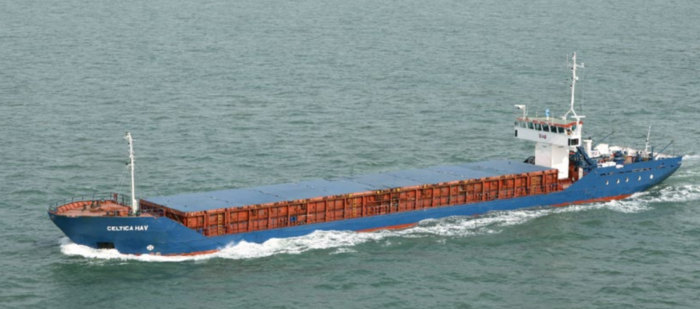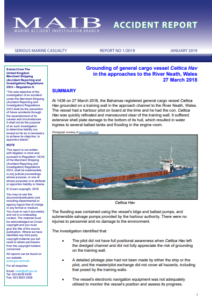UK MAIB published its report on the grounding of the general cargo vessel Celtica Hav. The vessel grounded on 27 March 2018 on a stone training wall in the approach channel to the River Neath, Wales. Celtica Hav was quickly re-floated and manoeuvred clear of the training wall. It sustained shell plate damage to the bottom of its hull, causing water ingress to some ballast tanks and flooding in the engine room.
The incident
On 19 March 2018, Celtica Hav started from Liepaja in Latvia, carrying 2070t of Anthracite, heading to Briton Ferry wharf on the River Neath, Wales. During the passage the ship’s agent advised Celtica Hav’s master of the draught restrictions at the discharge berth and instructed him to be ready to take a pilot and enter the River Neath during the afternoon flood tide on 27 March. Celtica Hav arrived in Swansea Bay on 26 March and anchored 1 mile south of the River Neath approach channel.
[smlsubform prepend=”GET THE SAFETY4SEA IN YOUR INBOX!” showname=false emailtxt=”” emailholder=”Enter your email address” showsubmit=true submittxt=”Submit” jsthanks=false thankyou=”Thank you for subscribing to our mailing list”]
The next day, Celtica Hav weighed anchor and proceeded to the pilot boarding station, where a little later, a Port of Neath pilot boarded the vessel and went to the bridge. The master and pilot exchanged information and completed the vessel’s Pilotage Check List. After the master/pilot exchange (MPX), the pilot sat in the starboard bridge chair, took the con and began to steer the vessel. The master sat in the port bridge chair and the C/O stood on the starboard side of the bridge.
The pilot boat coxswain checked Celtica Hav’s draughts and reported to the pilot on VHF radio a maximum draught aft of 4.13m. The pilot then told the coxswain to proceed inbound and wait by the tide gauge at the shore end of the River Neath approach channel.
The pilot was worried about Celtica Hav’s maximum draught aft and asked the master if it could be reduced. The master ordered a small amount of water to be pumped into the vessel’s forward wing ballast tanks. This rose the draught forward to 3.9m and reduced it aft to 4.05m. With the engine on slow ahead the pilot began a 360° turn to port. The pilot was aiming to lose time and allow the incoming tide to increase more before entering the River Neath approach channel.
After completing the 360° turn, the pilot increased the vessel’s speed to half ahead and steered Celtica Hav toward the entrance of the approach channel, which was marked by red and green lateral buoys. He then he manoeuvred the vessel around the starboard buoy and passed about 10m north of it at a speed of 5kts. He continued to steer the vessel inwards, maintaining a course that took Celtica Hav close to the starboard edge of the channel.
At 14.38, the ship left the dredged channel and grounded on the training wall. The ship scraped along the top of the training wall for about 200m before stopping around 600m from the Monkstone light beacon. The master stopped the vessel’s engine and instructed the crew to carry out a damage assessment. Because of the rising tide possibly causing the ship to scrape further along the wall leading to more damage, it was decided to refloat the vessel immediately.
The ship suffered extensive shell plate damage to the bottom of its hull, resulting in water ingress to several ballast tanks and flooding in the engine room. The flooding was contained using the vessel’s bilge and ballast pumps, and submersible salvage pumps provided by the harbour authority.
There were no injuries to personnel and no damage to the environment.
Probable cause
According to the UK MAIB, the following played an important role in the incident:
- A detailed pilotage plan had not been made by either the ship or the pilot, and the master/pilot exchange did not cover all hazards, including that posed by the training walls;
- The pilot did not have full positional awareness when Celtica Hav left the dredged channel and did not fully appreciate the risk of grounding on the training wall;
- The vessel’s electronic navigation equipment was not adequately utilised to monitor the vessel’s position and assess its progress.
Recommendations
Recommendations have been made to the Neath Port Authority and HAV Ship Management NorRus AS to improve the planning of pilotage and the quality of the master/pilot exchange of pilotage information.
See further details in the PDF below































































